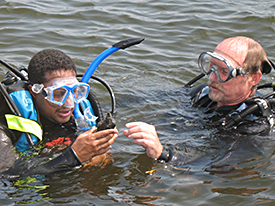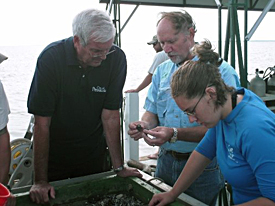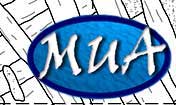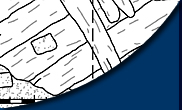After earlier difficulties with the unpredictable weather in the bay, it was a relief to begin the week with fair skies and no thunderstorms on the horizon. Monday saw a continuation of our previous week’s work in the amidships and stern units, and the opening of a new “control” unit. This unit, which is located outside the hull structure of the ship, is an innovative approach to learning more about wreck site formations. By excavating outside the formal limits of the wreck, we can gauge the archaeological impact of EPII on its marine surroundings. We are also able to see what we might miss by excavating only within hull structure or where a metal detector indicates artifacts will be.
A visit by family and friends of some of the crew gave us a chance to make visible some of the hidden wonders of the site through the use of an underwater video camera. The green-tinged images of hull structure, ballast pile, and a friendly angel fish had teams that had been diving those same waters for weeks glued to the monitor. Some of the crew also went to B street where dredging continued in the unit that was started last Thursday at the center of the hull. We were excited to reach the hull planking in this unit, and we found things such as nail fasteners, a few pottery shards, and some metal slag in our dredge spoil.
Tuesday brought us more visitors and more fine weather. Excavations continued in all three units with the roar of three dredges filling the air and sea. Hull planking, which had already been spotted in the stern unit, now began to pop up amidships. Crates of ballast stones were ferried non-stop from the unit to the ever-growing pile of rocks to the north, leading divers to develop their own underwater versions of the bunny-hop.

Dr. Bratten and Dr. Martin head down on EPII to excavate in the control unit.
The team excavating the control unit was happily surprised to uncover an olive jar fragment only 25 centimeters below the surface. Such finds give us clues to the extent of the artifact scatter created by the catastrophic last moments of the wreck and possibly the natural formation processes, which influence the site to this day.

Dr. Bratten tells Mayor Wiggins about an artifact he has just discovered in our dredge spoil.
Our streak of visitors continued Wednesday with the arrival of Pensacola’s own Mayor Wiggins. The mayor, after graciously saying a few words about the project, sorting some dredge-spoil, took the opportunity to get in the water himself and braved the strong current to snorkel above the site. Unfortunately, both for the mayor and the dive teams, visibility was extremely poor. That being said, there is nothing that can energize a team working blind quite like the feel of increasingly exposed hull planking. In the amidships unit, great progress was made, and spirits were high, as wood replaced the sandy and rocky mix of sediment at the bottom of the ballast level.
On Thursday crews set out to the barge and B-Street despite dark storm clouds threatening. The B-Street crew was able to do some more dredging, uncovering the hull and what was possibly a shipment of lumber that the ship was carrying. While meanwhile at EPII a new unit was being set up in the stern. Hopes are held high that this new unit may have a sternpost or possibly contain the rudder of the ship. The amidships unit became increasingly deeper and harder to dredge. The day was then cut short as the weather worsened. There was also a survey team sent out to do magnetometer and side-scan sonar in the hopes of finding an EPIII. The team did find some anomalies with their scans that will hopefully be searched in the near future.

Tim Holmes and Gary MacMullen observe the side scan sonar screen during their day of survey.
Friday was kept short and sweet. The crew continued to dredge in the stern and in our control unit. In the stern unit the hull has begun to emerge as we dredge deeper, and the control unit we’ve opened has revealed many artifacts. Our week of visitors continued we were also accompanied by our friend Dr. Martin, a chemistry professor at UWF studying bacterial growth. It was the first time Dr. Martin joined since going through scientific diver training with us way back in May. He explored the wreck, helped excavate, and collected more samples to continue his research.
We were excited to send a team out to do a target dive on some of the anomalies that were found during the previous day’s side-scan and magnetometer survey. They managed to fit in dives at two targets, but found nothing. However, in the world of archaeology knowing where things are not located is still good information to acquire. The crew then returned to MSC to do the usual equipment maintenance and cleaning. We also searched through the days dredge spoil finding things such as metal sheathing, some animal bones, and a few small sherds of pottery.
Please feel free to contact us if you have any questions or concerns at: mua@keimaps.com.
Return to Project Journal home page.



